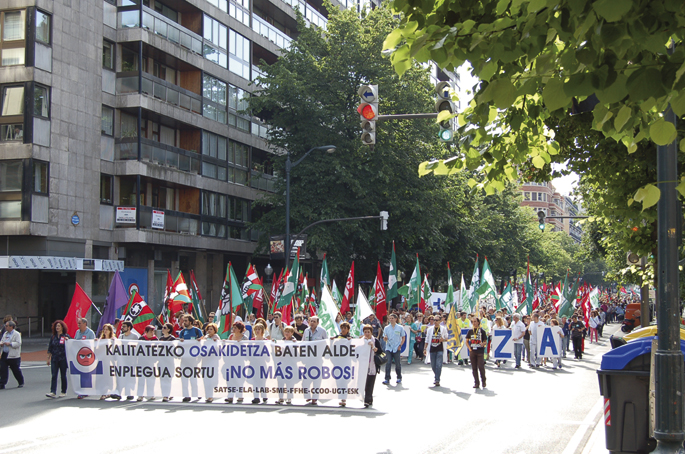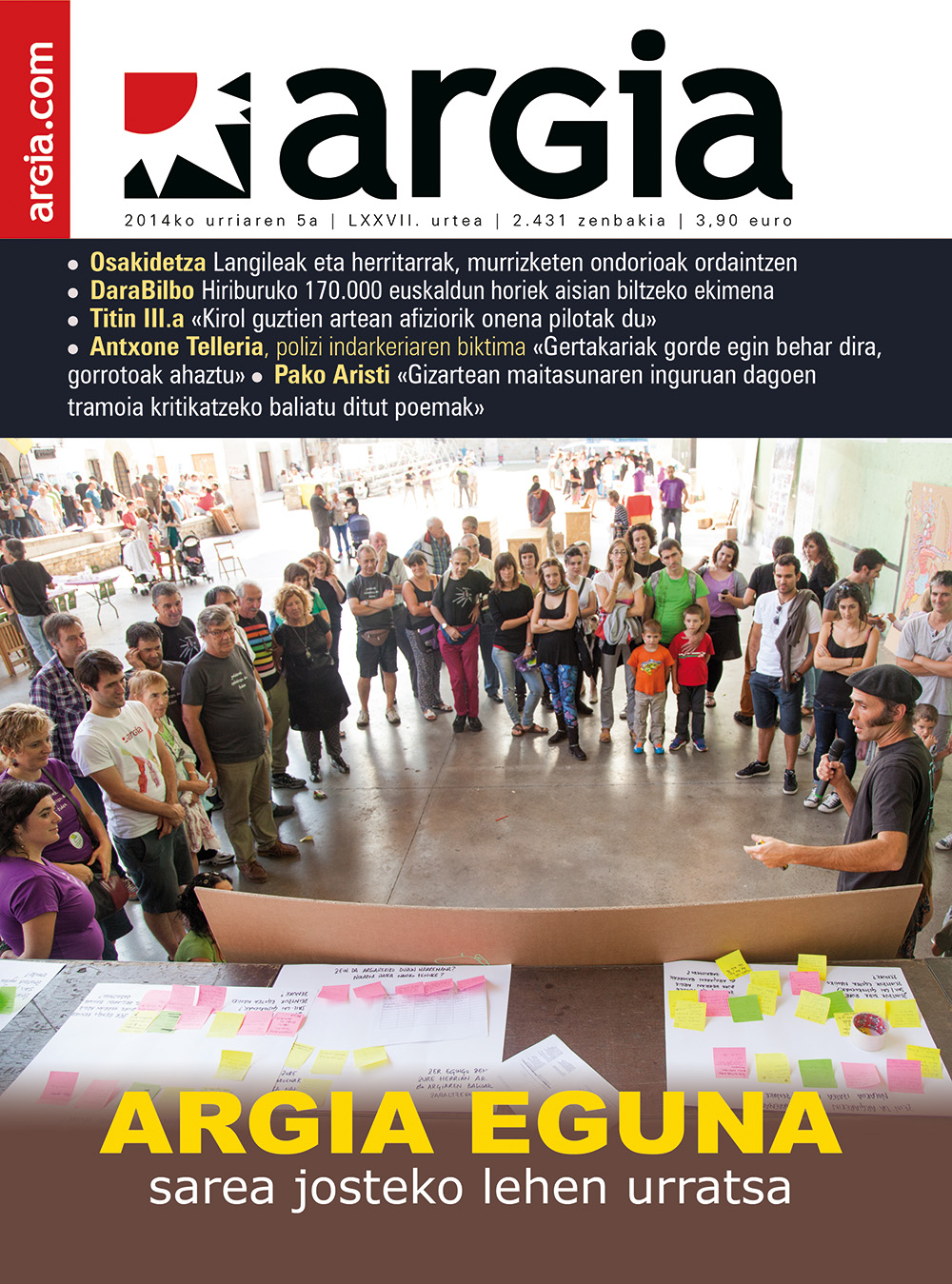There is no cure for the current conflict
- It has never been sweet, but the relationship between Osakidetza and the trade unions has deteriorated very much this year. To the cutbacks suffered by the whole public service since the beginning of the crisis are added certain health conflicts in the CAPV, which creates a situation that the citizens will pay a lot. Furthermore, it does not seem easy to find a recipe for consensus.

The timetable for mobilisations announced by the majority of the trade unions in Osakidetza remains in June. The meeting of the sectoral bureau on 15 September was the last opportunity to resolve the conflict before the autumn, but the result was quite the opposite: all the unions rose from the table and left, making the offers of the Osakidetza leadership ridiculous. Three days later, 12-hour enclosures were carried out in the main hospitals of the CAV, maintaining the call made in early summer. Thus began a series of mobilizations that will continue if there is no rapprochement between the parties. For the time being, it is almost certain that a demonstration will take place on 4 October and the trade unions have reaffirmed their call to end from 30.
The conflict is part of a series of measures imposed by the administrations as a result of the crisis. The head of ELA-Osakidetza, Pello Igeregi, summed up with a few sentences the situation that trade unions want to denounce: “In the past four years, Osakidetza has applied brutal cutbacks, some complying with orders in Madrid, others on his own. The conclusion is that workers have lost about 17% of their purchasing power in this period of time. We estimate that 3,000 jobs have been lost, the working day has been extended and the number of jobs has increased. It is clear that this affects the quality of service. Finally, Osakidetza decided in April to stop the call for Professional Development.” In the table on page 7 you will find an explanation of this last sentence.
Less money home
Many of the cuts suffered by Osakidetza’s staff are the same as those suffered by other staff. With regard to salaries, the Spanish Government hit them first in 2010, with Zapatero heading: By decree, it set a 5% drop. Since then, wages have been frozen. In the case of the CAV, they have also been removed from the allowances for Itzarri pensions.
“Itzarri is the Basque Government’s pension plan,” explains Igeregi, “until 1% of the wages that came from there are removed. At one point, Madrid decided that a supplement to pensions in public administrations could not be made, but the PNV reached an agreement, by means of an amendment, in order to be able to re-make those contributions.” ELA and the other trade unions denounce that, despite regaining authorisation, the Basque Government has not been willing to re-make contributions to Itzarri. The funny thing is that ELA is against Itzarri's model. Also LAB, basically, “because it is a private insurance that we have to pay the workers, that wants to replace the Social Security,” explains the head of Osakidetza within the union, Edurne Agirre.
How many workers does Osakidetza need?
Osakidetza is the largest company in the Basque Country (legally private, despite performing a public function). It has almost 26,000 fixed, structured workers, let's say. None of them has been lost in recent years, it is one of the arguments used by Osakidetza’s leadership to respond to trade union complaints. “We have a strong commitment to public employment and we will keep each of those 26,000 jobs. In addition, we intend to increase the staff,” Osakidetza replied to the question we have asked about it. On the contrary, those at the heart of the protest are not fixed workers, but newspapers.
“There are 25,800 permanent workers, but there are also thousands,” says Edurne Agirre, “we can say that the number of functional workers is about 32,000.” The difference lies in workers in precarious conditions; in some cases, those who worked six to nine months a year, replacing those who were on leave or on holiday or reinforcing service at certain times. We have used it in the past, because one of the most serious consequences of the cuts, in the words of the trade unions, is to recruit fewer and fewer workers for replacements. The days before nine months barely reach one month or two, as Agirre explained. And it's happened in all categories: doctor, nurse...
ELA believes that Osakidetza should have a maximum temporary rate of 7% and acknowledge that the rest of the staff – we are talking about 32,000 – is structural; if their work has ever been used, it is because there is a need. Instead, substitutions have been reduced and the working hours have been increased from 1,592 hours per year to 1,614. Osakidetza says that trade unions have no reason to complain, as they should take into account the general context. The day is extended to all officials, not only to those in Osakidetza. On the other hand, Lakua makes a comparison with the other communities of the Spanish State to repress the demands of those who protest against this protest. In some health services, the number of working hours per year has increased to 1,650 hours.
3,000 jobs and audit by Deloitte
According to the calculation made by ELA on its own, accused of lack of transparency and data retention to Osakidetza, the result of the reduction of substitutions is “the destruction of 3,000 jobs”. About a month ago, the results of the audit of the company Deloitte to Osakidetza were known, and the union says they confirm their calculations: almost 1,500 disappeared between 2012 and 2013.
The answer from Osakidetza is simple: if the working hours of permanent staff are increased, it is logical that there should be fewer temporary jobs. In a press release in early September, in response to ELA’s allegations, Osakidetza accused the union of activating the social alarm. Pello Igeregi has no doubt: “Of course we want to turn the alarm on! We want a good public health system, and we want to alert workers and society to mobilize to stop this destruction.”
Getting to OECD level
ELA wants a good public health system for the CAV, and Pello Igeregi believes he has had it for the time being. “A treasure that must be defended”, in his words. But how? Matching investment with the OECD average. “That means spending an extra EUR 1 billion each year, bringing us to our country.” In particular, some of this money has just been proposed: They call on Osakidetza to hire an additional 5,000 permanent workers. “This would serve to improve the services that work in Makal (teeth, mental health, gynecology…),” explains Igeregi, “and would cost 250 million euros. Some excellent facilities that are not used in the afternoon could be used and waiting lists considerably reduced.”
The question is who makes the comparison. Igeregi has used the OECD as a mirror, but it is more common to look at other autonomous regions of the Spanish State when it comes to dimensioning the situation in the CAV. The same week, in which Deloitte’s audit was discussed, for example, a study was made public that said, among other things, that Osakidetza is among the best public health services in the state. For ALS it is not a valid comparison; for Osakidetza yes, it cannot be said.
Impact of cuts on citizenship
Another of the great services of the Spanish State is that of Juan Luis Uria, president of the Osalde association that works for the right to health. We have come to him to ask him what the people are going to find the situation that the cutbacks are going to create. Uria said that the cuts "will be detrimental", although he felt that the consequences "will be lower than the trade unions denounce". In any event, it is considered that your call for mobilisations is fully justified at the time we are.
“It is clear that the citizens will notice the consequences of the cuts in some areas. Especially in major hospitals. Non-compliance with the 5,000 places covered by temporary contracts is serious and will necessarily entail consequences. It will be noted above all in specialized emergency care, waiting lists for some diagnostic tests and surgical interventions.” That's what Uria says. However, he was in favour of caution when making the complaint.
For their part, the unions complain that the cuts have reduced the quality of primary care and not hospital care. The Uría does not match: “I hear representatives of some trade unions and parties that everything in Osakidetza works badly. In Osakidetza it works badly... what works badly.” Specifically, and returning the comparison to the framework of the Spanish State, the president of Osalde considers that the quality of primary care is one of the main reasons why Osakidetza is among the best systems. Moreover, despite the fact that some substitutions have not been made, the situation has improved somewhat thanks to the introduction of the electronic prescription. “Especially nurses, and to a lesser extent doctors, have more time for other tasks.”
Osalde wants more flexible positions
We talked to Juan Luis Uria before the sectoral table on September 15. It can be deduced from his words that the outcome of the meeting did not surprise him: “Nothing has been negotiated for years. The trade unions have put the ‘all or nothing’ policy on the table: if you do not give me back the historic rights we have lost, I will go on strike. I'm not going to give them to you, Osakidetza replies. And the unions rise from the table.”
They rise up. We have just said: They have described Osakidetza’s offers as ridiculous and, above all, one: Commitment of the management of the creation of 60 new jobs. “I see the future with darkness,” says Uria, desolate. “Today, the institutional authorities prioritize the fight against the deficit, when in times of crisis they should do the opposite: invest more in public health, one of the pillars of social cohesion, together with education and social protection.” For the time being, the positions of Osakidetza and the trade unions are in the opposite direction, but Osalde says that there is room for negotiation: the company should provide incentives for workers (money, training, recognition of work…) and the unions should sit down and talk about it, without abandoning the fight for the recovery of historical rights.
Epilogue
By chance. Before making the final touches to the report, it has been in the outpatient clinic of the locality where the text has been signed, taking blood for analysis. When she noticed a puncture in her arm, she asked the nurse: “Look, how about working?” “Well, you’re seeing it, we’re two where three were needed.” At the exit, the journalist has noticed that two out of three reception staff wear a t-shirt with the "unrestricted" legend. It comes a long fall.
- Langileek eroste ahalmenaren %17 galdu dute sindikatuen esanetan. Osaldek dio %12 dela. Sindikaturen batek %20raino igotzen du kalkulua.
- 3.000 lanpostu galtzea leporatzen diote Osakidetzari, behin-behineko kontratuak egiteari uztearen ondorioz. ELAk dio guztira 5.000 lanpostu finko berri beharko lituzkeela Osakidetzak. Zuzendaritzak 60 lanposturen sorrera eskaini du azken mahai sektorialean.
- Urteko lanaldia 1.592 ordutik 1.614ra igo da batez beste. Langile batzuen kasuan, igoera 100 ordu ingurukoa da.
- Udan 1.171 ohe itxi izana salatu du ELAk, Osakidetzan dauden guztien %20. Ordezkapeneterako langilerik ez kontratatzearen ondorioz oporraldietan gero eta ohe gehiago ixteaz kexu dira orobat sindikatuak.
Garapen Profesionala berriz martxan jartzea da sindikatuek Osakidetzari egiten dioten eskarietako bat. Kontua nondik datorren azaldu digu ELAko Pello Igeregik: “2005eta 2006 urteetan egundoko gatazka zegoen Osakidetzan, orduan ere sindikatu gehienak batuta. Hura geldiarazteko, Osakidetzak Garapen Profesionala martxan jartzea erabaki zuen. Hiru parametro hartzen dira kontuan: antzinatasuna, formazioa eta langile bakoitzaren arduradunak langile horretaz idazten duen txostena”. Hirugarren irizpidea guztiz subjektiboa dela azpimarratu du Igeregik; izan ere, ELA eta beste sindikatu batzuk –ez denak– Garapen Profesional eredu horren aurka egotearen arrazoi nagusietakoa da hori. “Kontrolerako tresna dela iruditzen zaigu; bestetik, ez dago norberaren merituak neurtzeko irizpide objektiborik”. Formazioari dagokiona ere auzitan jartzen du Igeregik. Edozein ikastaro motak balio du, eta batzuk oso kalitate txarrekoak izaten dira, haren esanetan.
Kontuak kontu, sistema abian zen Osakidetzak aurten eten duen arte. Hain justu, 2011ko deialdia –oraindik ebaluatu gabe zegoena, bestela beste Jaurlaritzan aldaketak tarteko –utzi du bertan behera. “Horrek esan nahi du langileen arteko diskriminazioa sortu dela Oskidetza barruan: Garapen Profesionalari dagokion zatia kobratzen dutenena eta kobratu ezin dutenena”, azaldu digu Igeregik. Hori dela eta, sindikatu guztiek –ereduarekin ados egon ala ez– eskatu dute 2011ko deialdia ebatzi eta ordaindu dadin. “Horren ostean, sistema aldatzeko eztabaida zabaldu dadila nahi genuke”.
Osakidetzak adierazi digu gaiari buruzko proposamena egin zutela irailaren 15eko mahai sektorialean: “Hilabete batzuk lehenago eten izan behar genuen 2011ko Garapen Profesional prozesua burutzeko borondatea agertu genuen”. Bistan da, ez zela nahikoa izan sindikatuak mahaian jesarrita jarraitzeko.
Sindikatuek murrizketen testuinguruan kokatzen dute azken asteotan mobilizazio ugari eragin duen Osakidetza barruko gatazka bat: Bizkaiko Osasun Mental arloaren berregituratzeari dagokiona. Bereziki, Zaldibarko erietxe psikiatrikoko 35 oheren itxierak haserretu ditu (argazkia bertako protesta batean eginda dago).
Osasun Mentaleko ospitaleetan ohe kopurua murriztuz joatea estrategia zabal bati dagokio, zeinarekin printzipioz sindikatuak ados baitauden: zerbitzua deszentralizatzea eta ahal den heinean gaixoak etxean edo etxetik hurbileko zentroetan arreta jasotzea da helburua. Alta, LABeko Edurne Agirrek dio erietxeetakoa ixten hasi direla tarteko egitura horiek oraindik behar bezala osatuta ez daudela. Zaldibarkoa murrizketen testuinguruan bakarrik ez, Osakidetza osoaren pribatizazio estrategia orokor batean kokatzen du Agirrek.
Hala esatea gehiegizkoa dela uste du, aldiz, Osaldeko Juan Luis Uriak: “Murrizketak murrizketak dira eta Osasun Mentaleko aldaketak ezin dira hor kokatu. Komeni da gauzak ez nahastea”.
In 1813, Representative Lloret and Martí said: “The poor peasant and the simple soldier are the two classes most filled with pain and misery in the state. And it really is they who maintain the monarchy and the luxuries of the few individuals who integrate it,” and gives... [+]

























